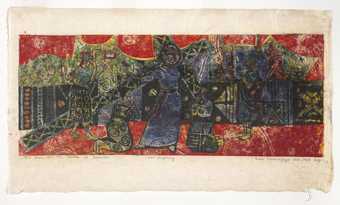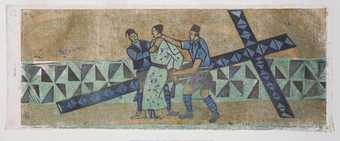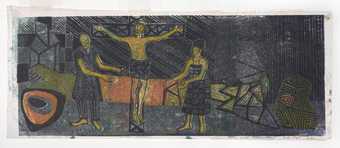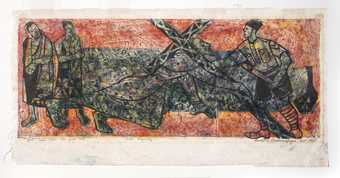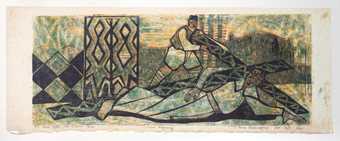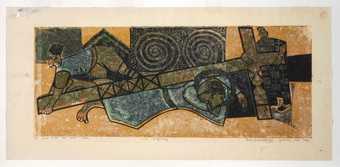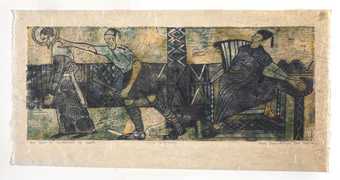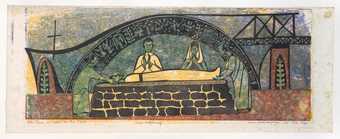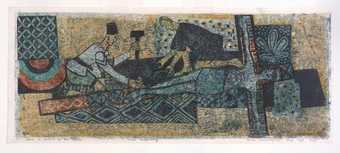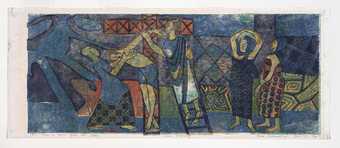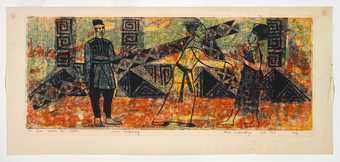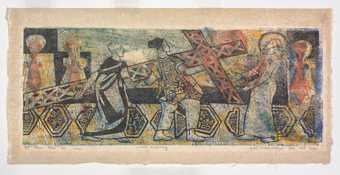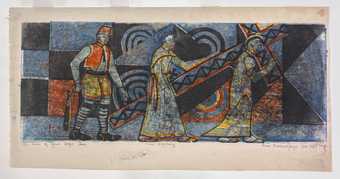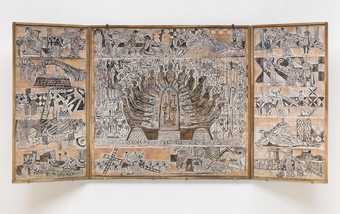
In Tate Liverpool
- Artist
- Bruce Onobrakpeya born 1932
- Medium
- Linocut on paper
- Dimensions
- Image: 243 × 600 mm
- Collection
- Tate
- Acquisition
- Purchased with funds provided by the Africa Acquisitions Committee 2019
- Reference
- P82234
Summary
This is one in a series by Nigerian artist Bruce Onobrakpeya comprising fourteen linocut prints on paper in an elongated landscape format. The subject is a biblical one, with each of the prints depicting a different moment from Jesus’ last days on Earth as a man, beginning with his condemnation by Pontius Pilate and ending with his crucifixion and laying in the tomb. The episodes portrayed – known in Christian theology as The Stations of the Cross – are precisely detailed and dramatised in Onobrakpeya’s prints, but have been placed within an African setting. The apostles wear vividly patterned local Adire prints and those restraining Jesus appear to be wearing colonial-era police uniform. The overall palette of the series is blue and green, with hints of yellow and highlights in orange. Geometric shapes abound, recalling patterns found on traditional Nigerian textiles and architecture. While these forms structure the compositions, they also extend onto the crosses that feature prominently in many of the images. The prints are individually titled as follows: Jesus is Condemned to Death, Jesus Takes his Cross, Jesus Falls the First Time, Jesus Meets his Mother, Simon of Cyrene Helps Jesus, Veronica Wipes Jesus’ Face, Jesus Falls the Second Time, Jesus and the Women of Jerusalem, Jesus Falls the Third Time, Jesus’ Clothes are Torn Off, Jesus is Nailed to the Cross, Jesus Dies on the Cross, Jesus is Taken from the Cross and Jesus is Laid in the Tomb. Thirteen of the prints are number eight in an edition of fifty. Jesus Falls the First Time is number eight in an edition of forty-eight. Complete sets of the prints are rare; although they can be shown individually, they are ideally shown all together as they were in the inaugural exhibition at Tate Modern, London in 2001, Century City: Art and Culture in the Modern Metropolis.
Onobrakpeya’s Christian upbringing in Nigeria and the experience of coming of age during the late colonial period has had a profound influence on his output. The Fourteen Stations of the Cross was made nine years after Nigeria gained independence from Britain during the Nigerian Civil War, commonly known as the Biafran War (1967–70). This series is based on a group of paintings completed by Onobrakpeya in 1967, which were commissioned for St. Paul’s Church in Ebute Metta, Lagos by Reverend Father Kevin Carroll. Carroll was born in Liverpool but relocated to West Africa in the 1940s, where he promoted resistance to the colonial imposition of European religious images and encouraged the development of a Yoruba Christian art and the preservation of local traditional art practices.
Onobrakpeya’s original paintings (which have been missing for several years) and prints were controversial at the time of their making, as has been noted by the artist and art historian Dele Jegede: ‘Some vocal members of the Ebute Metta parish considered the artist’s interpretation of the Bible as contemptuous in its characterization. The subjects looked so Yoruba to one writer, Father M.O. Sanusi … that he felt that it represented a distortion of history.’ (Jegede 2014, p.17) Fifty years later, it is widely recognised that Onobrakpeya’s works from the 1960s encapsulate the complexities of the encounter between Catholicism and the visual culture of the Yoruba under the conditions of late colonialism. As one of the co-founders of the Zaria Arts Society, or Zaria Rebels as they became known, Onobrakpeya and his colleagues aimed to decolonise arts education in Nigeria and supported each other in developing their own personal styles rooted in local subjects and artistic traditions. His influence on a younger generation of artists, notably through the annual Harmattan Workshop in Agbarha-Otor, which he established, is widely acknowledged. Onobrakpeya is particularly associated with pioneering experimental printing techniques and deep relief etched works which he called plastocasts. A later example of these, The Last Supper 1981 (Tate T15204), is also in Tate’s collection.
Further reading
Holland Cotter, ‘Bruce Onobrakpeya: Jewels of Nomadic Images’, in The New York Times, 16 November 2012.
Dele Jegede (ed.), Onobrakpeya: Masks of Flaming Arrows, Milan 2014.
Kerryn Greenberg
April 2018
Does this text contain inaccurate information or language that you feel we should improve or change? We would like to hear from you.
You might like
-
J.D. Okhai Ojeikere Untitled (Roundabout)
1974, printed 2012 -
Bruce Onobrakpeya Jesus and the women of Jerusalem
1969 -
Bruce Onobrakpeya Jesus’ clothes are torn off
1969 -
Bruce Onobrakpeya Jesus dies on the cross
1969 -
Bruce Onobrakpeya Jesus falls the first time
1969 -
Bruce Onobrakpeya Jesus falls the second time
1969 -
Bruce Onobrakpeya Jesus falls the third time
1969 -
Bruce Onobrakpeya Jesus is condemned to death
1969 -
Bruce Onobrakpeya Jesus is laid in the tomb
1969 -
Bruce Onobrakpeya Jesus is nailed to the cross
1969 -
Bruce Onobrakpeya Jesus is taken from the cross
1969 -
Bruce Onobrakpeya Jesus meets his mother
1969 -
Bruce Onobrakpeya Jesus takes his cross
1969 -
Bruce Onobrakpeya Simon of Cyrene helps Jesus
1969 -
Bruce Onobrakpeya The Last Supper
1981


